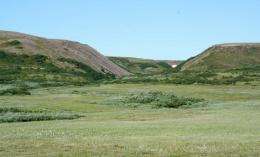Warming turns tundra to forest

(Phys.org) -- In just a few decades shrubs in the Arctic tundra have turned into trees as a result of the warming Arctic climate, creating patches of forest which, if replicated across the tundra, would significantly accelerate global warming.
Scientists from Finland and Oxford University investigated an area of around 100,000 km2, known as the northwestern Eurasian tundra, stretching from western Siberia to Finland. Surveys of the vegetation, using data from satellite imaging, fieldwork, and expert observations from indigenous reindeer herders, showed that in 8-15% of the area willow (Salix) and alder (Alnus) plants have grown into trees over 2 metres in height in the last 30-40 years.
Previous models assessing the potential impact of forestation have suggested that the advance of forest into Arctic tundra could increase Arctic warming by an extra 1-2 degrees Celsius by the late 21st Century.
A report of the research is published in the journal Nature Climate Change.
"It's a big surprise that these plants are reacting in this way," said Dr. Marc Macias-Fauria of Oxford University’s Department of Zoology and the Oxford Martin School, first author of the paper. "Previously people had thought that the tundra might be colonised by trees from the boreal forest to the south as the Arctic climate warms, a process that would take centuries. But what we've found is that the shrubs that are already there are transforming into trees in just a few decades."
"The speed and magnitude of the observed change is far greater than we expected," said Professor Bruce Forbes of the Arctic Centre, University of Lapland, corresponding author of the paper.
The change from shrubs to forest is important as it alters the albedo effect – the amount of sunlight reflected by the surface of the Earth.
In the Arctic spring and autumn much of the time shrubs are covered under a blanket of white, light-reflecting snow. In contrast, trees are tall enough to rise above the snowfall, presenting a dark, light-absorbing surface. This increased absorption of the Sun's radiation, combined with microclimates created by forested areas, adds to global warming: making an already-warming climate warm even more rapidly.
"Of course this is just one small part of the vast Arctic tundra and an area that is already warmer than the rest of the Arctic, probably due to the influence of warm air from the Gulf Stream," said Dr. Macias-Fauria. "However, this area does seem to be a bellwether for the rest of the region, it can show us what is likely to happen to the rest of the Arctic in the near future if these warming trends continue."
More information: A report of the research, entitled 'Eurasian Arctic greening reveals teleconnections and the potential for novel ecosystems', is published in the journal Nature Climate Change. The Finnish-UK team was led by Professor Bruce Forbes of the University of Lapland, Finland.
Journal information: Nature Climate Change
Provided by Oxford University















